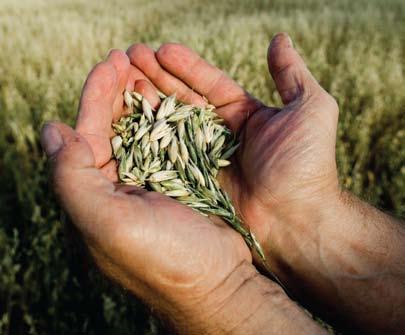
7 minute read
News
dr emma derbyshire phd rnutr (public Health) nutritional insight Ltd
dr emma derbyshire is a freelance nutritionist and former senior academic. her interests include pregnancy and public health. www.nutritionalinsight.co.uk hello@nutritionalinsight.co.uk
Advertisement
NeW eufic article oN geStatioNal diaBeteS
Gestational diabetes is fast becoming a rising health concern in pregnancy. Now, a new article published for the European Food Information Council (EUFIC) looks into the wider implications of this.
Most importantly, gestational diabetes (i.e. when a woman’s blood sugar levels in pregnancy become higher than normal) can affect the health of the mother and her baby. Over-growth of the foetus, leading to the delivery of larger babies (macrosomia) and subsequent delivery complications, are the main concerns, along with increased risk of pre-eclampsia.
Being a healthy body weight before becoming pregnant, being physically active, eating a diet that includes plenty of wholegrains, lean proteins, oily fish and polyunsaturated and monounsaturated fats, are key messages that should be communicated to women of childbearing age. Intakes of foods and drinks with a high glycaemic index should be kept to a minimum.
For more information see: Derbyshire EJ (2015) Food Today. Available at: www. eufic.org/article/en/artid/The_rising_ concern_of_gestational_diabetes/
NutS aNd Blood preSSure: NeW metaaNalySiS
Past work has looked at how certain nuts affect blood pressure, but findings have been mixed. Taking this on board, a new meta-analysis has pooled data from 21 randomised controlled trials.
Findings showed that pistachios significantly reduced systolic blood pressure (P=0.002), while both pistachios and mixed nuts led to significant reductions in diastolic blood pressure (P=0.04). These findings were most apparent in subjects without Type 2 diabetes.
Overall, eating pistachios may help to reduce both systolic and diastolic blood pressure in healthy adults without Type 2 diabetes. Eating mixed nuts may also help to lower diastolic blood pressure.
For more information see: Mohammadifard N et al (2015) American Journal of Clinical Nutrition Vol 101 no 5, pg 966-982.
So, WHat did adam aNd eVe eat?
Eating habits which are not in line with our evolutionary progress are thought to be fuelling an epidemic of obesity and diet-related diseases, such as cancer and cardiac problems. Now a new review has looked into this in more detail. The article exploring how nutrition influenced the development of Homo sapiens concluded that genetically, we are still stone-age hunter-gatherers who thrive on lean meat, fruits, vegetables and nuts, but, environmentally, we are surrounded by foods laden with sugar, simple carbohydrates and the wrong type of fats.
Overall, the evidence base identified that we were likely to have evolved as omnivores with animal products playing a key role in brain development and acquisition of skills. In addition, the same evidence noted that trialists who ate a diet of lean meat, fruits, vegetables and nuts, while avoiding cereal grains, dairy and legumes had lower blood pressure and lower blood levels of glucose, LDL cholesterol and triglycerides after just 10 days. And other evidence revealed significant reductions in body weight, waist measurement and blood pressure.
Hence, later shifts towards a cerealbased diet are likely to have happened too suddenly for our genome to adapt appropriately. This, in turn, is likely to have increased non-communicable disease risk.
maiN SourceS of Sodium after BirtH
Sodium intakes are high in the US and this trend starts early in life. New data from the highly-regarded National Health and Nutrition Examination Survey (NHANES 2003-10) has now looked into the main exposures during the first two years of life.
Data was analysed from 778 infants aged 0-5.9 months, 914 infants aged six to 11.9 months and 1,219 toddlers aged 12 to 23.9 months. It was found that sodium intakes were lowest in the youngest children but exposures increased with age.
With weaning (six to 11.9 months) commercial baby foods, soups and pasta mixed dishes provided extra sodium. In the oldest age group cheese and sausages were some of the main sources of sodium. Restaurant foods also provided nine percent of sodium.
Overall, this shows that most sodium comes from foods other than infant formula or human milk once children begin weaning. It also highlights the need to educate parents about how restaurant settings can increase children’s exposure to sodium.
For more information see: Maalouf J et al (2015) American Journal of Clinical Nutrition Vol 101 no 5, pg 1021-1028.
pareNtS iNflueNce oN cHildreN’S eatiNg HaBitS

Emotional eating can lead to childhood obesity, but where does this stem from? Now, latest work has looked at how parental control in early life may play a role in this.
The study recruited 41 parents with a child aged between two and five years. Baseline data about feeding practices was collected and then families were followed up again two years later. At this point parents were observed feeding their children who were then exposed to an emotional stressor or a control and snacking habits were monitored.
Results showed that parents who used food as a reward, or restricted food for health reasons in the earlier years, were more likely to have children who ate more under conditions of negative emotion at age five to seven years.
These are interesting findings implying that parents who overly control their children’s food intakes may be doing more harm than good. This may inadvertently lead to children relying on palatable foods to cope with negative emotions.
For more information see: Farrow AV et al (2015) the American Journal of Clinical Nutrition. Vol 101 no 5, pg 908-913.
takiNg a look at tHe germaN NatioNal NutritioN SurVey ii
As well as looking at food intakes in the UK, it’s important to look at trends in other parts of Europe. New data has now been published from the German National Nutrition Survey (NVS II) which measured food intakes in 15,371 subjects aged 14 to 80 years, comparing this with German Nutrition Society (DGE) guidelines.
The survey found that German men consume twice as much meat and soft drinks and drink six times more beer than women. Women, however, tend to eat more vegetables and fruit and drink more herbal/fruit tea. Older subjects consume less meat, fruit juice/nectars, soft drinks and spirits, but more fish, vegetables, fruit and herbal/fruit tea than younger adults and teenagers. People from lower socio-economic groups also eat more meat/meat products and drink more soft drinks and beer.
Overall, these findings show that German males, younger populations and lower socioeconomic groups have the most concerning food intake patterns, with a tendency for these to fall short of official dietary guidelines.
For more information see: Heuera T et al (2015) British Journal of Nutrition Vol 113 Issue 10, pg 1603-1614.
lateSt oN WHolegraiNS
Bda to Support a NeW aWard iN memory of pat Judd aNd Her Work

Wholegrains (WGs) are undoubtedly important for health, but, at times, comparing findings between studies can be cumbersome. Now, conclusions from a new paper published in The American Journal of Clinical Nutrition recommends several approaches to ease this. These include reporting WG intakes in grams, as dry weight; defining the term WG in the paper; describing the different types of grain used; describing the structure of grains used, i.e. intact, crushed, partially milled etc; describing the products and processes used to make the WGs.
Most recently, median WG intakes (on a dry weight basis) were measured in the UK 2008-11 National Diet and Nutrition Survey. Data analysed from 3,073 people showed that median WG intakes were 20 grams per day for adults and 13 grams per day for children, with teens and young adults having some of the lowest intakes. Interestingly, 18 percent of adults and 15 percent of children/teens did not report eating any WG foods at all.
A second paper by the same team of scientists also showed that adults with the lowest WG intakes had significantly higher levels of C-reactive protein (a marker of inflammation). Consumers eating WGs also had nutrient intakes that were more closely in line with dietary reference values for fibre, magnesium and iron and lower intakes of sodium, indicating that higher WG intakes may also be associated with improved diet quality.
These are important findings, highlighting the need to continue encouraging WG consumption, especially amongst teenagers and young adults. Improved reporting in studies will also enable high quality meta-analysis papers to be complied in the future.
For more information see: Ross AB et al. (2015) American Journal of Clinical Nutrition Vol 101 no 5, pg 903-907; Mann KD et al (2015) British Journal of Nutrition Vol 113, Issue 10 pg 16431651 and Mann KD et al (2015) British Journal of Nutrition Vol 113 Issue 10, pg 1595-1602.
In memory of Pat and her work, her family and friends have set up a BDA award with the aim to raise enough money to cover the support of a PhD for a dietitian.
The details have not yet been finalised, but those wishing to contribute to the award are invited to do so.
Please send a cheque made out to the BDA General and Educational Trust, addressed to Pat Judd Memorial Award, c/o Andy Burman, Secretary to the Trustees, The British Dietetic Association, 5th Floor, Charles House, Queensway, Birmingham, B3 3HT.’










